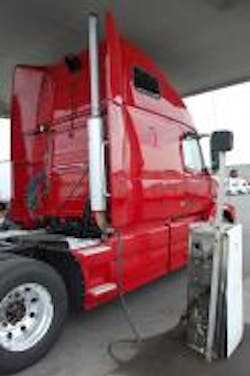“We believe we can avoid any major cost increases to meet the standards until 2017. But then we’re going to need new systems like waste heat recovery, which will add cost and complexity.” –Steve Charlton, chief technical officer for Cummins Engine Co., about the new heavy truck fuel economy rules being promulgated by the U.S. government
As everyone knows by now, new fuel economy rules are about to be plopped on top of the trucking industry – ostensibly in an effort to reduce carbon dioxide (CO2) emissions; a major “greenhouse gas” that causes global warming and “climate change,” according to the Environmental Protection Agency (EPA).
You can read about the EPA’s position on the dangers posed by greenhouse gases here, but the short version is basically this: CO2 is created when gasoline and diesel is consumed, so using less fuel reduces greenhouse gases. Thus, cars, light and heavy trucks are now going to face higher fuel economy standards than ever before.
What does that mean for big rigs? The overall goal of the coming rule is a 3% improvement in fuel economy by 2014 compared to 2010 performance, according to OEMs speaking at the recent American Trucking Associations management conference held last week, with a 5% gain by 2017, and as yet unspecified improvements phased in by 2020 and beyond.
How those improvements will be measured will vary by truck size and application, but both truck manufacturers and engine makers will be required to certify fuel economy performance gains.
But here’s the larger question: HOW are truck OEMs and trailer makers going to reach such fuel economy targets? Because these new standards are going to require “total vehicle solutions” in order to reach such ambitious fuel economy goals, not just improvements to the engine or tractor alone.
Even small changes are being looked at to help in this area – stuff like making the physical components of the truck, such as the cab structure, from thinner pieces of metal and other materials. Carl Fredrik Hartung, product area manager at Volvo Technology in Sweden, talk about some of these “lightweight technologies” below:
Figuring out how to move trucks in a more fuel efficient manner is another key piece of this puzzle, and “smarter” transmissions offer one possible solution. European truck maker Scania, for example, rolled out a new version of its “Opticruise” system last year with a variety of tweaks to enhance this technology’s ability to deliver fuel savings.
That includes giving it the ability to know when a truck is running fully loaded or not and totally disengaging the clutch when stopping to reduce fuel consumption.
[Note, however, that the driver in Scania’s video below must still MANUALLY raise and lower the trailer landing gear with a hand-crank. It’s funny to still see this rudimentary process in existence alongside all this super-modern technology.]
Then there are efforts to totally “re-think” how trucks fulfill their freight and work roles within society; especially in terms of urban operations.
That’s the goal of Europe’s three-year “FIDEUS” project, short for Freight Innovative Delivery in European Urban Spaces, conducted from 2005 to 2008.
That effort looked for ways to improve not just the fuel and emissions footprint of trucks, but dampen down operating noise to allow for more “off peak” vehicle operation at night to avoid traffic congestion as well as the potential to contribute to it.
No doubt this project is being mined even as we speak by European truck OEMs and fleets alike to find ways to improve vehicle operation not only to reduce pollution but to improve “logistical efficiency”: as well.
These are just some of the many strategies now being deployed worldwide to reach some very ambitious fuel economy standards. Yet how successful OEMs and fleets will be remains to be seen.
